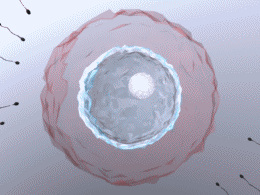|
Conception
|
|
Fertilization
|
|
|
|
|
Fertilization:
Only one sperm cell penetrates the outer layer of the egg cell. The head of the sperm cell and the nucleus of the egg cell then unite and form a new cell: the zygote.
|
|
When an egg is released from one of the ovaries, it almost immediately enters the open end of the adjacent Fallopian tube. As it travels down this tube toward the uterus, it matures to become ready for the union with a sperm cell. Within a few hours, the egg reaches maturity while it is still in the upper third of the Fallopian tube. This is the time when the sperm should arrive if a fertilization is to occur. The entire period in which egg and sperm can unite is less than 24 hours. If no such union takes place, the egg dies and disintegrates. However, moving into the Fallopian tube, the egg may very well encounter live sperm cells which have arrived and stayed there following coitus several days before. (Sperm cells have been found alive inside Fallopian tubes up to five days after coitus.)
|


